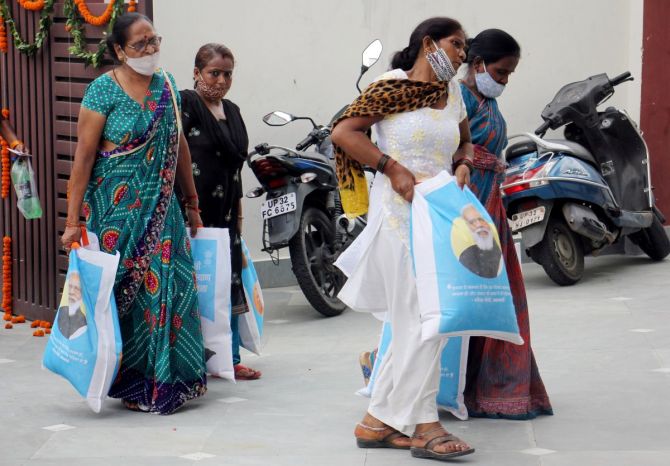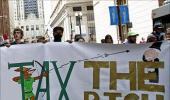There are reports that the government will soon cut income taxes by about Rs 50,000 crore to boost consumption.
Prime Minister Modi, I suggest that, instead, you distribute about one lakh crore rupees per year to the 80 crore poor, which will boost both consumption and economic growth, suggests Kalyan Singhal, McCurdy Professor of Business at the University of Baltimore.

Prime Minister Modi,
The free distribution of grains to the poorest 80 crore Indians has done wonders for India's economic growth.
By allowing the poor to spend more money on non-food items, the programme created a multiplier effect of between two and four. That is, the distribution of every rupee worth of free grain produced two to four rupees of economic growth.
This effect is the reason that India's recent economic growth has been far greater than even the most optimistic forecasts.
Whether directly or indirectly, the whole country benefitted from the free distribution of grains.
The multiplier effect works as follows: Assume that, because they received free grain, the poor have an extra 1,000 rupees apiece and that they spend it on goods and services.
The producers of these goods and services, some of whom are in higher income groups, now have an extra income of 1,000 rupees.
If they, in turn, spend 800 rupees consuming other goods and services, those producers will receive 800 rupees of extra income.
As this process continues, the economy will increase by about 2,000 to 4,000 rupees, reflecting a multiplier effect between two and four.
There is some risk, though. If the production of the goods and services that consumers choose cannot be increased quickly, the extra spending will lead to inflation without boosting economic growth.
This effect is stronger with the goods and services consumed by the rich than by the poor because the economy of the poor always has more slack.

Some leaders have smugly asserted that lowering income tax rates for the rich brings in more revenue.
As well as being an acknowledgement that the rich cheat, this assertion is a lie.
When Arun Jaitley abolished property taxes and increased income tax rates to compensate, the supporters of the smug doctrine said nothing in Parliament, though they had always claimed that increased income tax rates would reduce income tax revenue.
Their conspicuous silence implicitly acknowledged that they had been consciously lying all along.
In India, only 2.3 crore people pay income tax. They and their dependents constitute the richest eight crores of the population.
India's industry leaders have recently demanded tax cuts for these wealthy few, bizarrely referring to them as 'middle class'. (Indeed, given that these leaders have classified the eight crore richest as 'middle class' and the official poverty rate of about 10 percent makes only 14 crores 'poor', one wonders what our industry leaders would call the remaining 122 crores.)
I would like to ask these industry leaders two questions: Do you know the income distribution in India, by, say, deciles? And how is India's GDP of 333 lakh crore rupees divided between personal consumption; consumption by private organizations; consumption by the central, state, and local governments; investment by governments; investment by companies; investment by individuals; and so forth. I feel confident that most of them do not know the answers to these basic questions.
Prime Minister Modi, the fact is that I could not find the answers to these two questions either.
How can the government make policy decisions that affect all Indian people without this basic information? Economists and government officials have kept you and all of India's prime ministers back to Nehru in the dark by suppressing it. You must ask the Niti Aayog to produce this information right away.
There are reports that the government will soon cut income taxes by about fifty thousand crore rupees to boost consumption.
Prime Minister Modi, I suggest that, instead, you distribute about one lakh crore rupees per year to the 80 crore poor, which will boost both consumption and economic growth.
This amount would provide each adult and child an extra 1,250 rupees per year or each family of four an extra 5,000. Alternatively, you could devote the same funds to increasing the free grain distribution.
One lakh crore is a small fraction of India's rising GDP of 333 lakh crore rupees and all political parties would support fueling the economy.
The Jan Sangh chief and your hero, Deen Dayal Upadhyay, was the first to suggest a minimum guaranteed income for all Indians. You can find the idea in the Jan Sangh manifestos of 1957 and 1962.

In 2020 and 2021, at the peak of COVID, I requested that you give 2,000 rupees per month to every child and adult.
I don't know if anybody brought my proposal to your attention, but you did implement a softer version of my recommendation by starting the free grain distribution.
However, because of the way COVID was handled, the real income of the poorest 20 percent decreased by 21 percent between 2016 and 2023 while the real income of the richest 20 percent increased by 51 percent.
These numbers offer a way to support your indignation with those who still call for tax cuts for the rich.
As a share of the gross domestic product after interest payments, government revenues are 14.4 percent in India, 25.4 percent in the US, 34.6 percent in the UK, and 35.4 percent in Japan.
The rate at which high incomes are taxed is much lower in India than in the other three countries.
US residents pay a progressive federal income tax, state income tax (in most states), and a 15.3 percent payroll tax on income up to $168,600. India needs to increase, not decrease, its taxes.
The money for distributions to the poor could come from three sources: The money that your government apparently intends to give to the rich in tax cuts, the money you could collect in additional taxes by eliminating certain deductions and exemptions that have no moral or economic rationale, and printing money.
It is simple enough to not give money to the rich. I would be happy to identify for you the deductions and exemptions that should be eliminated.
Printing money is a double-edged sword. If a government prints money and spends it without any corresponding increase in the production of the goods and services, it will simply create inflation.
The same is likely to happen if a government prints money and gives it to the rich, who may invest it in nonproductive assets like gold and real estate. But by printing money and giving it to the poor, your government will, in all likelihood, boost economic growth without increasing inflation.
Kalyan Singhal is McCurdy Professor of Business at the University of Baltimore, a management scientist, and an economist. He is a 1967 graduate of IIT Bombay; a former professor at IIM Bangalore; a Fellow of INFORMS, along with several Nobel Laureates; lifetime editor of Production and Operations Management, one of the top journals on the Business-Week and Financial Times lists; and lifetime co-editor of Management and Business Review which Forbes called a rival to the Harvard Business Review.
He can be reached at Ksinghal@ubalt.edu
Copyright Kalyan Singhal. All those interested have my permission to print and distribute this article after informing me at Ksinghal@ubalt.edu
Feature Presentation: Rajesh Alva/Rediff.com










